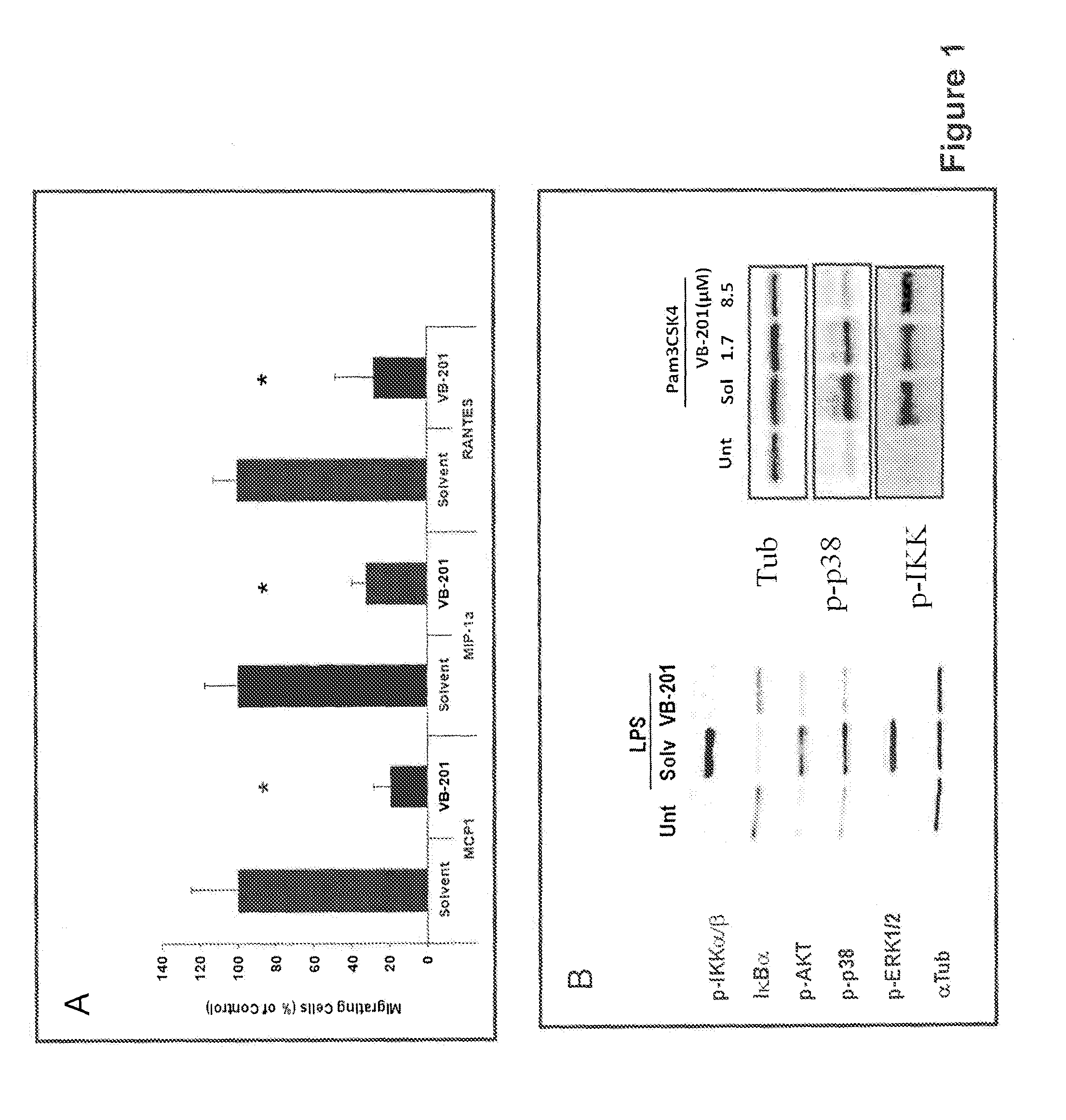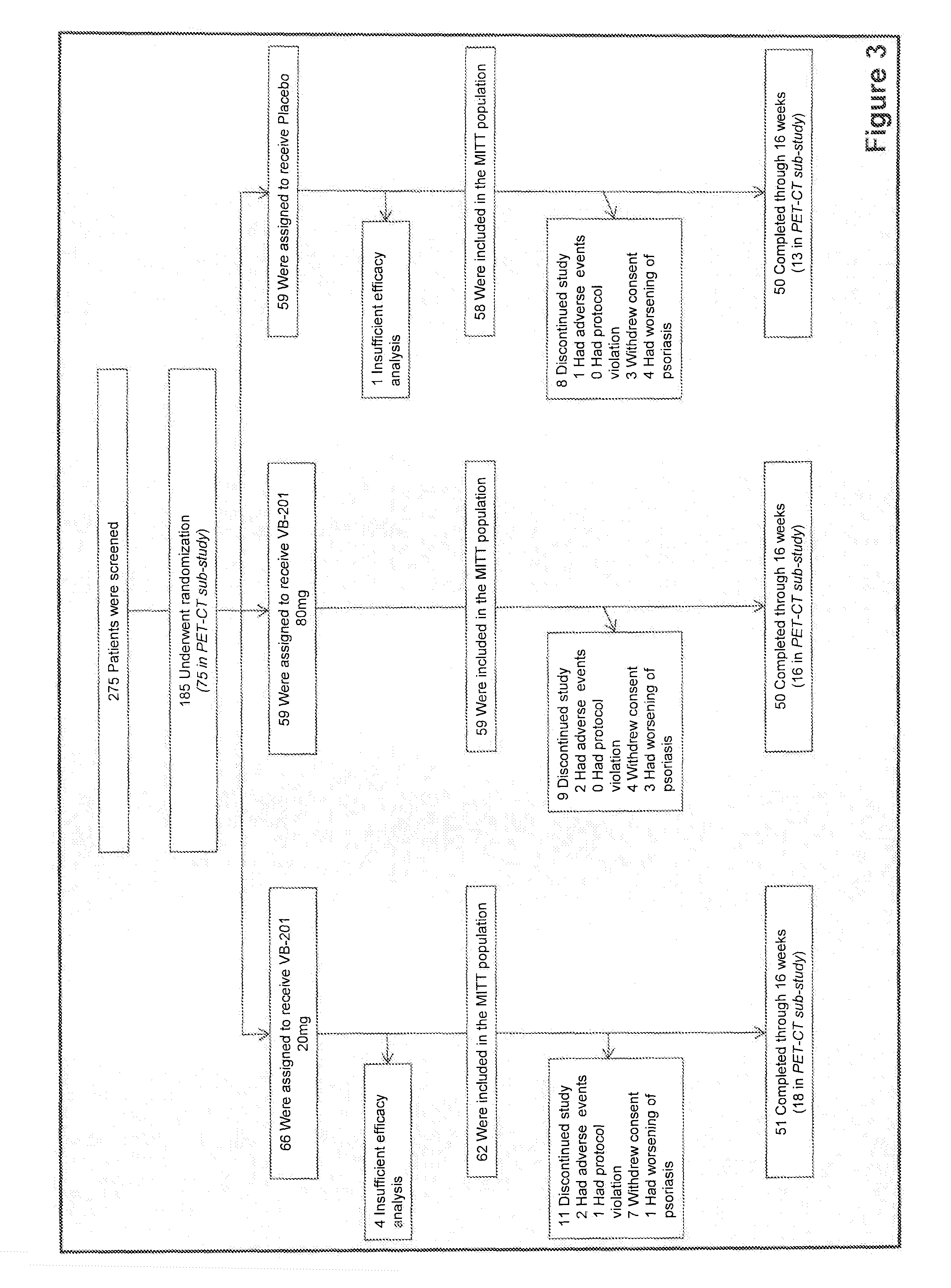Methods for treating psoriasis and vascular inflammation
a technology of vascular inflammation and psoriasis, which is applied in the field of methods for treating psoriasis and vascular inflammation, can solve the problems of acute renal failur
- Summary
- Abstract
- Description
- Claims
- Application Information
AI Technical Summary
Benefits of technology
Problems solved by technology
Method used
Image
Examples
example 1
Safety and Efficacy of VB-201 on Vascular Inflammation of Atherosclerosis as Measured by FDG PET / CT Imaging
[0182]The safety and efficacy of VB-201 was evaluated for treatment of patients with moderate to severe plaque psoriasis. As psoriasis is associated with increased atherosclerotic cardiovascular morbidity and mortality, VB-201's effect on vascular inflammation using 18-fluorodeoxyglueose (18-FDG) PET / CT imaging of the carotid arteries and ascending aorta was evaluated.
Methods:
Overview of the Phase 2 Clinical Trial Design
[0183]The general study design for the phase 2 clinical trial is shown in FIG. 2. Patients were screened for eligibility and, up to 28 days later, at the baseline visit, randomized to one of three treatment groups (1:1:1): VB-201 20 mg / day: VB-201 80 mg / day: placebo / day. Patients consumed 2 capsules per day (VB-201 20 mg+placebo, VB-201 40 mg+40 mg, or 2× placebo). To ensure that the treatment assignments were concealed, all patients received 2 matching capsules...
example 2
Efficacy of VB-201 in a Patient with Inflammation Associated with an Implant
[0203]A patient with breast implants was treated with VD-201 at 20 mg / day for 12 weeks. PET-CT scans were done at baseline and at 12 weeks, using positron emission computed tomography (PET / CT) imaging quantifying 18-fluorodeoxyglucose (18-FDG) uptake as a TBR as described in Example 1.
[0204]The efficacy of VB-201 in treating inflammation associated with the breast implant is shown in FIG. 6. The patient had inflammation associated with the breast implants prior to the treatment of VB-201, see the white arrows pointing at 18-FDG uptake near the breast implants in FIG. 6. The patient had reactive inflammation in response to the implants, which may tissues surrounding the implants. At 12 weeks, reduced inflammation surrounding the breast implants of the patient was observed, see the white arrows pointing at 18-FDG uptake near the breast implants in FIG. 6. However, the effect of VB-201 in reducing inflammation ...
example 3
Efficacy of VB-201 in Patients with Plaque Psoriasis
[0206]A randomized, double-blind Phase II clinical study was performed in subjects with moderate to severe plaque psoriasis, in order to determine the efficacy of VB-201 in treating this condition. Patients (men or women in the age of 18-75 years) were selected if they had a diagnosis of plaque psoriasis for at least 6 months and they had moderate (i.e., scoring at least 3 on a 0 to 5 point Physician Global Assessment (PGA) scale) to severe, stable and active plaque psoriasis vulgaris affecting at least 10% of the body surface and with a Psoriasis Area and Severity Index (PASI) score of at least 12. Patients underwent a wash-out period following any previous treatments. After screening and establishment of a baseline, eligible subjects were randomly assigned to receive 20 mg per day VB-201, 80 mg per day VB-201 or a daily placebo, for a period of 12 weeks.
[0207]Doses were administered orally at breakfast time with food. The maximal...
PUM
 Login to View More
Login to View More Abstract
Description
Claims
Application Information
 Login to View More
Login to View More - R&D
- Intellectual Property
- Life Sciences
- Materials
- Tech Scout
- Unparalleled Data Quality
- Higher Quality Content
- 60% Fewer Hallucinations
Browse by: Latest US Patents, China's latest patents, Technical Efficacy Thesaurus, Application Domain, Technology Topic, Popular Technical Reports.
© 2025 PatSnap. All rights reserved.Legal|Privacy policy|Modern Slavery Act Transparency Statement|Sitemap|About US| Contact US: help@patsnap.com



